The actor who played Spidey on The Electric Company gave this rare interview in 2017…
—
UPDATED 11/27/25: Danny Seagren, the actor who played the first live-action Spider-Man, on the great ’70s kids’ show The Electric Company, has died at the age of 81. Perfect time to reprint this interview from 2017. — Dan
—
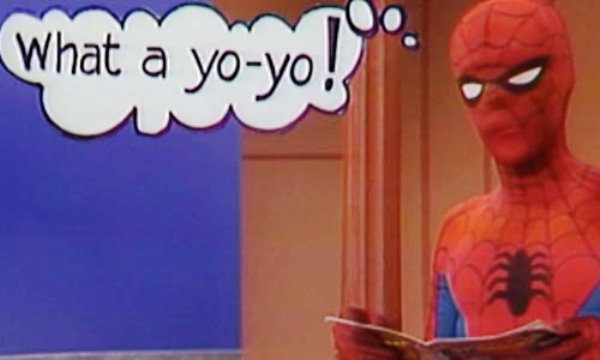
As Young Dan, I was part of the first Sesame Street generation, which only goes to follow that I was also a devotee of its spinoff, The Electric Company. Obviously, the highlight of any episode was the appearance of Spider-Man, who starred in a series of goofy, yet entertaining, segments. The main thing was that Spidey never spoke. Instead, kids were encouraged to read his dialogue. The man under the mask was a dancer and puppeteer named Danny Seagren, who’s now 73*. Writer Mark Edlitz tracked him down and got him to reveal all about being screendom’s first live-action web-slinger. Dig it, True Believers! — Dan
By MARK EDLITZ
When I was working on my book How to Be a Superhero, which collects 35 interviews I did with actors and actresses who have played superheroes, villains and sidekicks in movies and TV during the past seven decades, I had hoped to speak with Danny Seagren. Unfortunately, I was unable to track him down at the time; but this time I had better luck.
So for me, this interview was a welcome opportunity not only to address unfinished business but also to speak with the first actor I saw playing Spider-Man. And because there was no spoken dialogue in Spidey Super Stories, this interview also gave me the chance to hear Seagren’s voice for the first time:
Before Nicholas Hammond, Tobey Maguire, Andrew Garfield and Tom Holland, Danny Seagren played the first live-action Spider-Man. From 1974-77, Seagren portrayed the web-slinger on the children’s television show The Electric Company. His version steered clear of Spidey’s usual lineup of ferocious foes, like Doctor Octopus and the Green Goblin, and instead battled child-friendly villains like the Funny Bunny, the Birthday Bandit and the Prankster.
The light-hearted skits, called Spidey Super Stories, were designed to appeal to kids. Think Saturday Night Live meets Mister Rogers’ Neighborhood. As the series’ predominantly youthful audience was told by the segments’ narrator, Seagren’s Spider-Man was not above taking the “day off from his exhausting and frustrating war against crime [to] catch the baseball game,” where he’d sit in the stands, nonchalantly wearing his Spidey costume and, incongruously yet charmingly, a Mets baseball cap. If you caught The Electric Company at just the right age it served as an affectionate introduction to a beloved character.
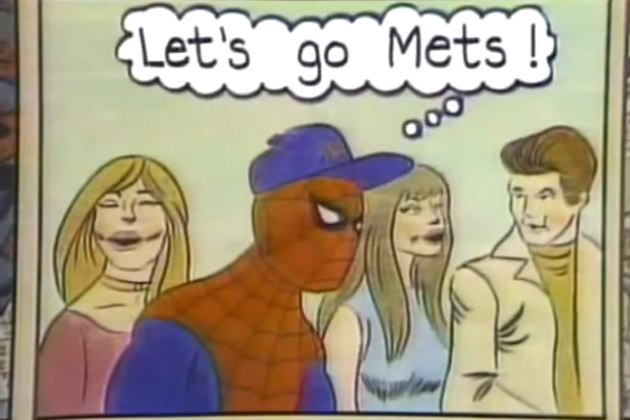
The 29 three-to-five-minute segments are fondly remembered for their catchy theme song, which expresses wonder about Spidey’s identity — “Spider-Man, where are you coming from? Spider-Man, nobody knows who you are” — for the enthusiastic performance by future Oscar-winner Morgan Freeman in a variety of roles, and for Seagren’s athletic and balletic wall-crawler.
The pun-heavy segments were spun off into a Marvel tie-in comic titled, fittingly, Spidey Super Stories. The comic lasted an impressive eight years — finishing five years after The Electric Company ceased production. The cover art was often clever — especially a memorable illustration of Spider-Man triumphantly holding up a light saber, a la Luke Skywalker, with Dr. Doom serving as a stand-in for Darth Vader.
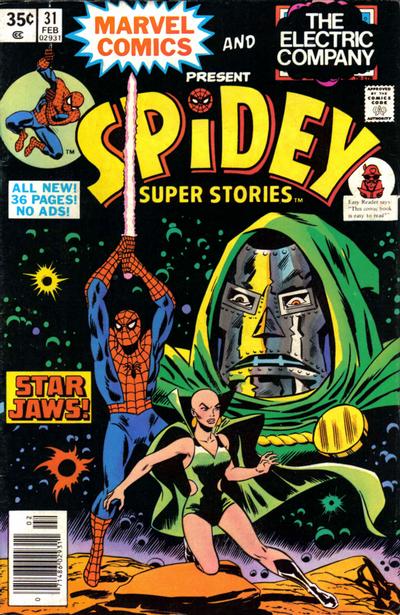
Pencils possibly Keith Pollard, with Frank Giacoia inks, according to the Grand Comics Database.
With the web-slinger back on the big screen in Spider-Man: Homecoming, it’s a welcome opportunity to catch up with the first actor who played your friendly neighborhood Spidey.
—
Mark Edlitz: How did you come to be the first live-action Spider-Man?
Danny Seagren: I was working at the Muppets at the time. So I knew a lot of the people working at the Children’s Television Workshop, who were making Sesame Street and The Electric Company. I heard they were looking for someone to play Spider-Man. Because I had some good connections, I got myself an audition. But the one person who I didn’t know was the producer of The Electric Company, Andrew Ferguson. I went in, met with him, he took me down the hall to the music room and said, “Put the costume on. I’ll be back in a couple of minutes.”
I put the costume on and I thought I’ve got to knock his socks off, somehow. In the room there was a filing cabinet and a desk. I climbed on top of the filing cabinet. When he came back into the room I jumped over his shoulder – but not quite over his head – and landed on the desk in the middle of the room. I don’t remember if he screamed but he said, “Oh my God.” I did a few more moves and he said, “You got the job.”
Mark: What was the concept of the Super Spidey segments?
Danny: The Children’s Television Workshop got the rights for Spider-Man from Marvel for nothing; they didn’t pay anything for them. They producers of the show knew they wanted something that kids could relate to easily. They also knew they wanted to copy the comic-book format. As Spider-Man, I never spoke dialogue. Instead, there would be thought bubbles with words in them, which would come out of Spider-Man’s mouth. If the kids wanted to follow the story, they had to read the thought bubbles. It was remedial reading. The target audience was 7- to 10-year-old kids who never learned to read in the first and second grade.
Mark: Was there ever any discussion of having Spider-Man talk?
Danny: He was never meant to talk. There was no Peter Parker. I was a faceless, silent mime. There was not a lot of job security. They could put another body in the costume if they got mad at me. But I managed to hold the job for three years until the show went out of production.
Mark: I didn’t notice at the time but the special effects were a bit crude.
Danny: We had very little money for special effects. So they would insert the web shooting out of Spider-Man’s wrist in (post-production). One day they brought a large web to set. The plan was that I would pretend to shoot the web, they would have us freeze while shooting the scene and the prop guy was supposed to come out and throw the web on the villain, the Sandman. But when they yelled “freeze” the prop guy came out and threw the web on me and not on the bad guy.
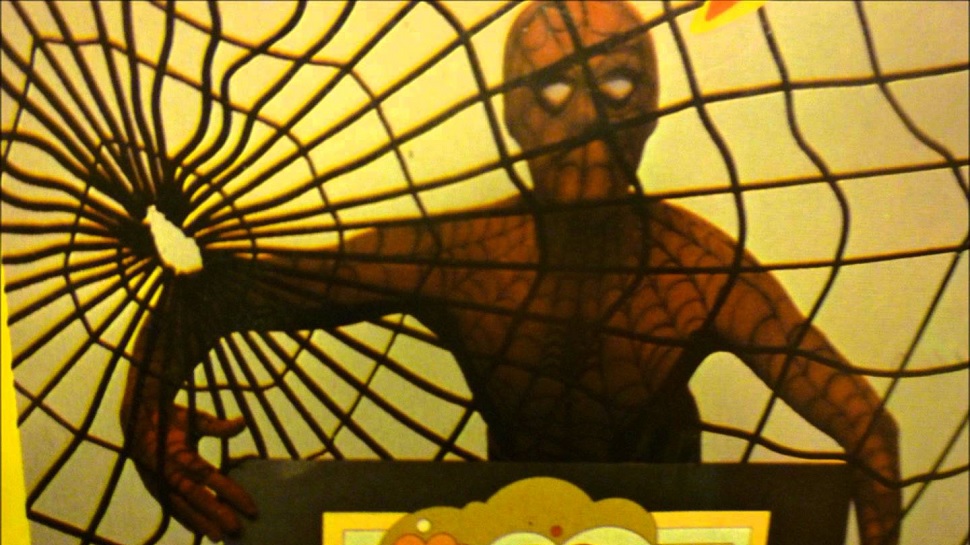
Mark: The prop guy was clearly not versed in even the basics of Spider-Man lore. How did you come up with Spider-Man’s movement?
Danny: I had a number of Spider-Man poses and a distinctive way I would shoot the web (that resembles an underhand pitch). I was a fan of Spider-Man and I had seen the animated series, a lot. Plus, I was a professionally trained dancer. So I had some moves and a grace, which is important because Spider-Man has a grace about him, slinking around. Before the first show, I had spent some time trying some things to do with my body so that I would have a repertoire of Spider-Man moves.
Mark: What was the schedule like?
Danny: I don’t think I ever did two segments in a week. We only shot one a week. But we spent a fair amount of time shooting each segment. I also spent a lot of time in chroma key (a technique used to combine separate images). Because the Spider-Man suit was blue and red, we used a green chroma key. It was a big screen that came down to the floor and across the floor so that they could take the character and set him anywhere. They had backgrounds of scenes from comic books and they would put me in them. The lighting had to be perfect because if you had shadows, they would key-out, cause the background to disappear, and it would look like a shadow across the screen. If that happened, they would stop and spend quite a bit of time relighting and start again.
Mark: How did you feel in the costume? Did you ever feel silly?
Danny: I never felt silly. I was focused on trying to be a superhero. I wasn’t a muscle man but I worked out and had a good body. I had the powerful legs of a dancer. I was trim and I went to the gym all the time. I think that’s why they wanted me. I think before they cast me that they saw some muscle men but they couldn’t move.
I always took it seriously. I tried to keep it in mind that I was powerful and strong. But, at the same time, I was fighting bad guys like Mr. Measles and the Sitter, who was a guy in drag. The situations were silly but I tried to rise above them. I had to be a little bit campy for the whole thing. I really enjoyed doing it. I always looked forward to the shooting days.
Mark: Any difficulties while wearing the suit?
Danny: The little netting of the suit that covered the eyes made it hard to see, especially when the bright TV lights hit it. So sometimes it was hard to hit my marks.
Mark: How would you describe the tone of the segments?
Danny: It was clearly farce. Most comedy skits are farce.
Mark: How did you approach the part?
Danny: I knew that I had to play it straight against all the farcical elements. I always try to stay in character. The segments themselves weren’t that long, about 5 minutes or so and they weren’t that complicated.
Mark: You would also do personal appearances in costume?
Danny: Yes, the show had two costumes. An agent approached me, said that he got the license from Marvel and that he could book me. The show gave me permission to make appearances. I got the person who made the Spider-Man costumes from the show to make me one. It cost me $300. It was identical to the ones used on the show.
The agent had a lot of contacts and I started getting a lot of bookings. The first appearance I did was in Florida. I also did one with Adam West and Burt Ward, the first of which was in Chicago. They would go out in their Batman and Robin costumes on the hour and I think I went out on the half hour. We would do it five or six times in an evening. The fathers who brought their kids were the right age to be Batman fans and luckily our show was also very popular.
Nobody knew who I was, but because the character was on the show, I had a following. I got gigs in Hawaii and all around the country. It was almost every weekend for a couple of years. I sold a lot of pictures at the shows and it was an excellent source of income.
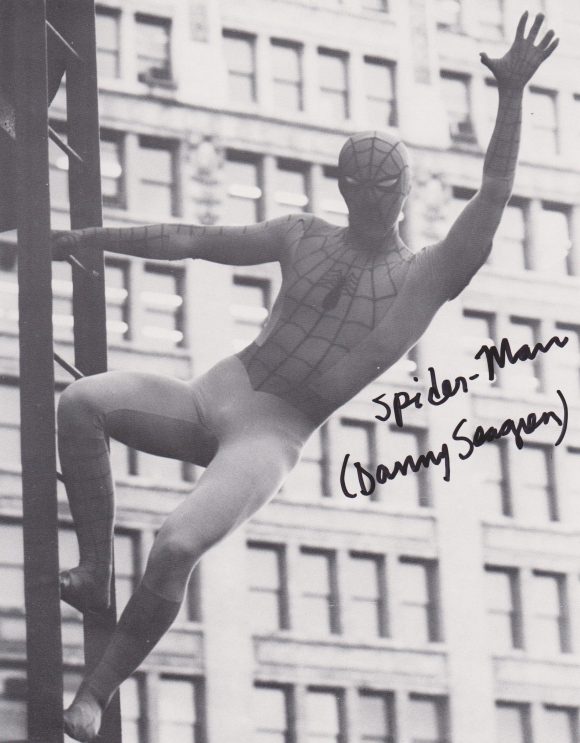
Mark: Do any appearances stand out?
Danny: Yes, one in a shopping mall. I had multi-appearances throughout the day at the same venue. Maybe I’d show up every hour on the hour. Between appearances I would put my clothes on and walk around the mall. I was walking around the mall and there was a little girl who might have been 7 years old and she looked at me and I looked at her and smiled. She turned to her mother and said, Mommy that’s him, that’s Spider-Man! The mother said, no, no, no. I said yes, yes, yes. I was in street clothes and I thought, how does this girl know? But she somehow sensed that I was Spider-Man.
Mark: I remember wanting to go to a Spider-Man appearance at a toy store in New Rochelle (just outside New York City), but for some reason we arrived late and Spidey was gone. Was that you?
Danny: Possibly, but I don’t remember doing toy stores. I would usually do big malls.
Mark: OK, I feel a little better.
Danny: But there were other people doing Spider-Man who weren’t on the show. Marvel also had their own guys. I also did some appearances with Marvel. I remember being at LaGuardia Airport. There was another superhero who was a total joke named Captain Sticky. They wanted to get pictures of Spider-Man with Captain Sticky. But there was a bomb scare and we had to leave the airport. There we were in the parking lot, me in my Spider-Man suit waiting for the bomb scare to clear. I felt a little bit stupid.
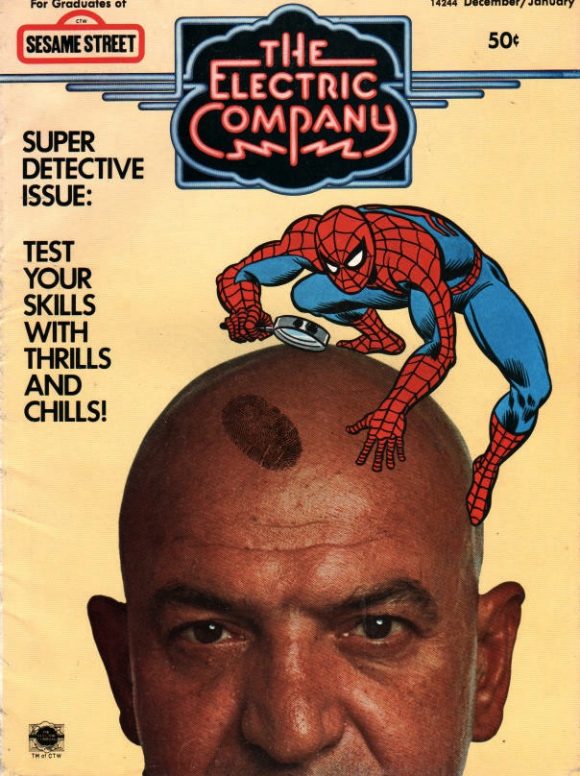
Mark: How did the appearances work?
Danny: If I were in a shopping mall I might, for example, appear at 1:30, 3:00 and 5. I would go out and talk for a few minutes and give a quick backstory about Spider-Man for those who didn’t know it. I would go to Marvel’s offices and read back issues of Spider-Man so I could answer the audience’s questions because I was getting a lot of questions that I didn’t know the answer to. I would go to their library, which was rather incomplete at the time and read through their back issues.
Each appearance was always a little different. Sometimes it was at a state fair, sometimes it was at a car show. I did a couple of strip malls where there were empty stores and they wanted to get excitement about the strip mall. But it didn’t matter to me what it was because all the appearances paid the same. Maybe the car shows paid a little bit more, but it was fun to do.
I was always in the costume and at the end of each appearance I would go back to the dressing room and change out of the costume and put on my street clothes. Sometimes, there were kids hanging outside the dressing room. If there were, I would pretend that I was talking to a guy playing Spider-Man and I would say, “OK, I’m going to get you a sandwich and I’ll be back in about 20-minutes.”
Mark: Where is the costume now?
Danny: It’s in my office.
Mark: How does it look?
Danny: It looks faded. It’s about 40 years old. I do comic-book conventions now and I do not wear the costume but I bring it with me. I have several pictures that I autograph and sign for $10 apiece.
Mark: Were you concerned about typecasting?
Danny: Fortunately or unfortunately, it didn’t affect my career at all. Nobody knew who I was.
Mark: Your segment was successful enough that it had a spin-off comic.
Danny: Yes, it was called Spidey Super Stories and they gave me a free subscription to it. I don’t know where they are now but I’m sure they have value. After the initial production, the show ran for about six or seven more years. (Note: The show ran from 1971 to 1977, then went into reruns until 1985. It popped up again years later on cable.)
Mark: In preparation for talking with you, I rewatched the episodes and it looked like Morgan Freeman was having a great time in these fairly silly sketches.
Danny: From Morgan Freeman to Rita Moreno, it was a very talented cast. When I got there, they had been working on The Electric Company for three years, so they were very familiar with how the show worked. All the people were good to work with and they were very nice to me. Morgan was into it. He was not just walking his way through it. Before he was an actor, he was in the Air Force and then he was in the chorus of Hello, Dolly! with Pearl Bailey, which ran on Broadway. He worked on Electric Company and Joseph Papp at the New York Shakespeare Festival took notice of him. Then he was cast in Driving Miss Daisy, first the play and then the film, and then his career took off from there. (Note: Around the time of the play in the late ’80s, Freeman was in the movie Street Smart and earned his first Oscar nomination.)
Mark: Did you meet Stan Lee?
Danny: I met Stan Lee a couple of times. The first time I met him was at a reception at the Rainbow Room (at 30 Rockefeller Center). I don’t remember what the occasion was but there were Spider-Man posters there. Somebody introduced him to me and said, “Stan, do you know who this is?” Stan replied, “Is that the new Captain America?” Then I was introduced as the new Spider-Man and he was quite gracious. I don’t remember if I asked him any questions about Spider-Man because I was so intimidated by him. Even back then, he was a superstar.
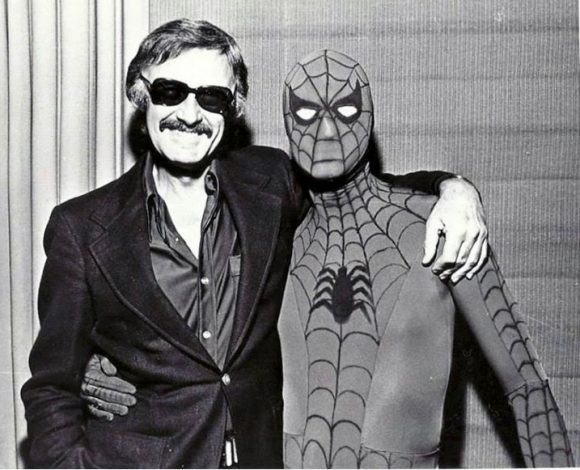
Mark: One Muppet story please.
Danny: I played Big Bird in 1969 on The Ed Sullivan Show. It was to promote Sesame Street, which was a new show at the time and they were trying to get all the publicity they could. Caroll Spinney has played Big Bird forever. If I talk about Big Bird, I always talk about Caroll. But there was a dance number and Caroll wasn’t really a dancer. Jim Henson said, “I think Danny should do it.” So, I did.
After the number, Ed Sullivan said, “Come here. Come here.” So, I walked over with the girls who played the Bird Watchers in the dance number. I bent down to give a little bow and I accidentally pecked him on the head. He said, “OK, girls take him out before I give him the bird.” I did that show probably five or six times, it was always fun. It was live for about 35 million people. With Ed Sullivan, I started at the top and worked my way down.
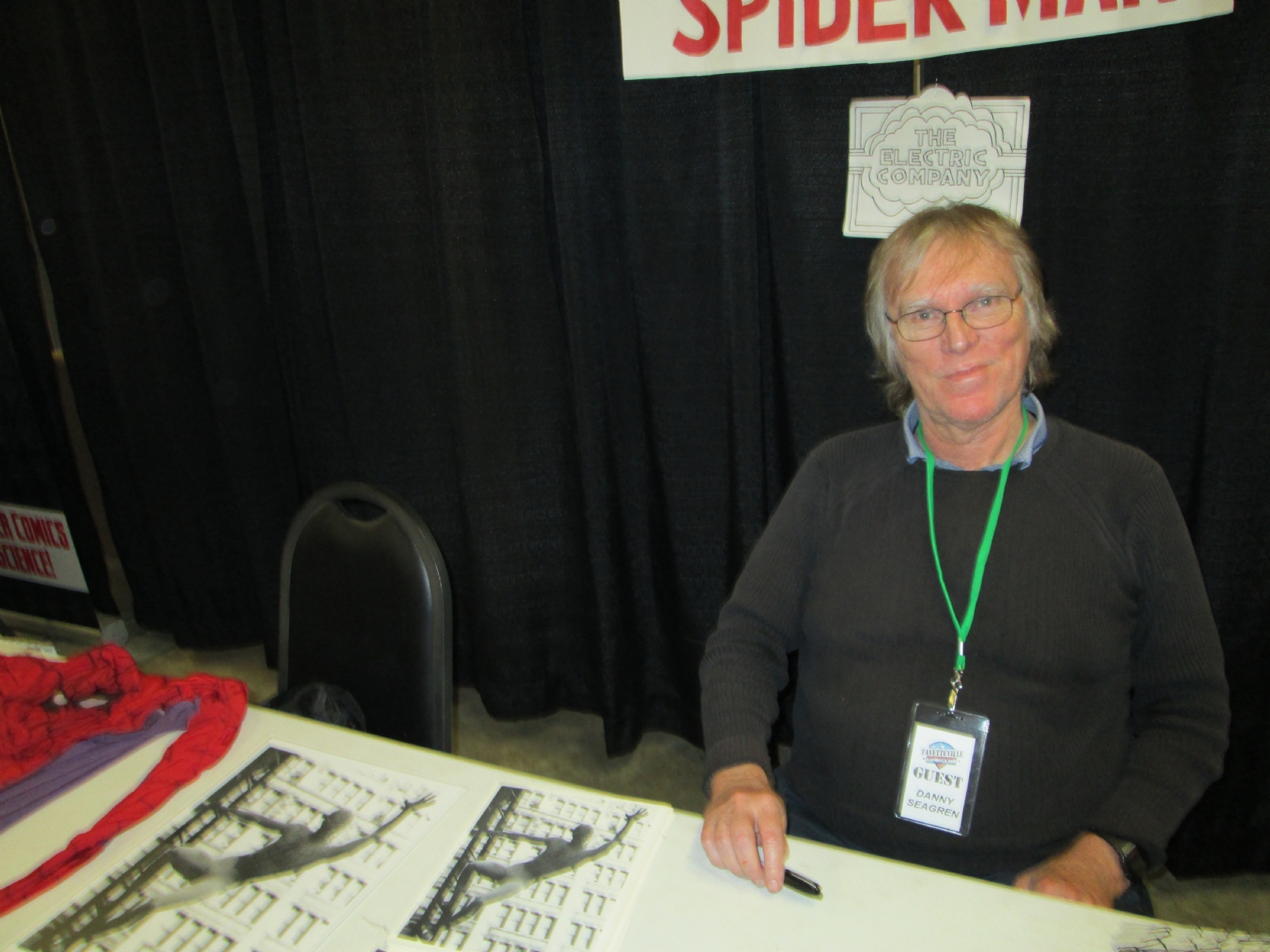
Seagren in 2015, from comicartfans.com. Note the costume on the left.
Mark: What does it mean to you to be the first Spider-Man?
Danny: Well, for a long time it didn’t mean much. After the show ended, I went on and I did Captain Kangaroo for a few years and that was working with puppets. It was on my resume but it wasn’t on the top. But years later, people started tracking me down and I started to do comic conventions. It can be kind of flattering when people take the trouble to track me down. When I do comic conventions, I meet people who are in their late 40s who are big fans of the show. They really remember the show and they say that I was their favorite character. That’s very flattering. Your call is very flattering. Who doesn’t like to talk about themselves? (Laughs). It’s a very nice feeling.
© Mark Edlitz, 2017. For more on Mark’s How to Be a Superhero, including interviews with Adam West, Julie Newmar, Lou Ferrigno, Roger Moore and more, click here.
—
MORE
— SPIDER-MAN VS. MYSTERIO: Their Groovy ’67 Cartoon Showdowns. Click here.
— 13 QUICK THOUGHTS on SPIDER-MAN: FAR FROM HOME. Click here.
—
* Seagren was 73 when this first ran.

August 2, 2017
Hey man, good memories of this. And good to hear from the real guy. It doesn’t surprise me that he was a dancer. He did lend a special flair to Spider-Man. And I’ve said it before, say it again, I thought his costume was really (for the most part) the most faithful adaptation of any one portrayed yet on screen. I’d prefer that to the souped up technology filled one Tony Stark provided for Peter.
It was always a treat to get to see Spidey super stories on the Electric Company. Our class used to go across the hall to Mr. Wilson’s room in 6th grade on Friday mornings to have what was essentially a dead time in school Something schools would never allow these days, but man I remember those times more than I do any book learning from that year. We’d watch Electric Company and right after that the teachers would change the channel to the Gong Show. I think I was the only student in the room who was watching. I soaked both shows up. It was real learning.
August 2, 2017
That’s a great memory! Thanks for sharing it.
August 2, 2017
Between this and the 67 animated series in reruns…this was how many of us met Spider-Man. As a kid, I did always wonder why we didn’t see Peter Parker, and why he didn’t speak.
I saw Spidey and the Green Goblin at a Hills store in Lexington, KY around 1980. It probably wasn’t Mr. Seagreen, but that Spidey did a back flip and landed in a patented Spider-Man crouching position on a circular clothes rack! I was convinced he was the real-deal.
Great interview!
August 2, 2017
Thanks for the nice words about the interview.
August 2, 2017
Big Bird is portrayed by Caroll Spinney, not Spivey.
August 2, 2017
Duly corrected!
August 3, 2017
In August of 1978, at the mall in Erie PA, they opened up a superhero shop with a Spider-Man appearance (I still have the photo of me at age 10 sitting on his lap.) The costume was pretty good but it definitely wasn’t Seagren’s suit. I also remember he was giving away copies of Amazing Spider-Man 186.
August 6, 2017
Hey !!! i watched the cartoon as a kid… never had the chance to own spiderman comics (3rd world country benefits :/ ) but reading this guy answers made me smile !!! it seems like he really loved that and that he still cherish these simple memories !!! it’s nice ^^ !!!
August 6, 2017
Thank you, Gosseyn!
August 8, 2017
Here is the Ed Sullivan Big Bird segment he refers to in the article – https://www.youtube.com/watch?v=L3FTJsrAUhI
March 22, 2018
Really great interview!! He seems to be a really neat person.
March 14, 2019
Wow! One of the greatest interviews.You know you’re a “real super-hero” when a mere kid knows who you are without donning your threads on. ( The little girl that told her mom: “…hey that’s Spider-Man!” SUPER-HEROES also have the power to teach us how to read, when they don’t want to learn how to do it. I haven’t seen such power on display since the early days of VERBMAN from SCHOOLHOUSE ROCK! Thanks for sharing Mr.Greenfield. (I’m something of an Author myself because them.)
I still occasionally watch my Electric Company collection.
May 4, 2019
Thrilled to have come across this interview & these videos & photos. Brings back special memories. Little River?
May 4, 2019
So glad to have come across these interviews, videos & photos. Brought back special memories. Wondered many times where Danny Seagren was. Little River?
July 11, 2019
If you were a kid at the time, the live action Spidey on the Electric Company was friggin’ mind blowing stuff! Things have come a long way since then. Anyway, really enjoyed this interview. Had no idea who this guy was, but it sounds like he had fun. I’d definitely stop and say hello if I saw him at a convention.
July 13, 2019
This was so awesome ! Big thank you for the behind the scenes look. Loved EC back in the day and of course the Spidey segments!
December 12, 2019
Thanks for publishing the interview. I remember my brother and I would wait eagerly for Spiderman to appear everytime we watched the Electric Company
October 29, 2021
“Danny: Fortunately or unfortunately, it didn’t affect my career at all. Nobody knew who I was.”
JUST LIKE IN THE THEME SONG!!!
August 14, 2022
Spider-Man was the highlight of my day qhen watching The Electric Company. I’m 53 now, and Spidey is still my all-time favorite superhero. Thanks for the trip down memory lane.
September 13, 2023
Thanks for this! I didn’t see “Electric Company” until I was in College in the late 70s. (Our PBS reception was crappy for years!) My college buddies and I would sit in the dorm, watch the show and laugh our heads off. We thought it was funny and better than SNL! And comics geek me had bummed through a few of the comics issues (including the one with Lockjaw of the Inhumans!)
January 23, 2025
I remember seeing Spider-Man at the Macon Mall (in Macon, Georgia) in 1977. Spidey even autographed our comics that we bought at the mall drug store off the spinner rack. I do remember Spidey talking to a large crowd in the 2 story mall and thinking how cool that was. I also remember someone asking him to shoot his webs and he replied that he hadn’t brought them with him. Years later, noticing that I had Amazing Spider-Man #174 with the Punisher (this was when the Punisher was a “hot” book) and thought, “hey, that book’s valuable since it had the Punisher in it” and then noticed that “Love, Spidey” was written on the back cover and then thought, “no it isn’t”. All in all, a great memory.
January 23, 2025
Macon, GA…..we stop there every time we head to north GA. Gotta make a stop at the Buc-ee’s.
November 29, 2025
Rip Hero